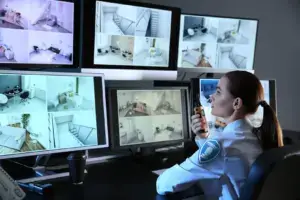Thermal security imaging may sound like something from Star Trek. It’s here, though, and it may just be an idea whose time has come.
If you’ve been researching thermal security cameras, you know that they can not only transmit video to a remote monitor just like any security camera, but also take the temperature of people who pass through their line of sight.
In the age of coronaviruses, that’s huge. One of the symptoms of COVID-19 and many other dangerous conditions is a fever. Imagine if you could set up a thermal camera at your entryway and be alerted when someone who’s running a 100-degree fever walks through your front door.
That’s the promise of thermal security. Let’s think about how to actually achieve that promise.
Protect Your Workforce with Highly Accurate Temperate Readings
Checking temperatures with thermal cameras isn’t just a nice idea—it’s becoming a best practice. The CDC recently recommended that this become standard practice for anyone entering workplaces, schools and childcare centers in the Silicon Valley and Seattle metropolitan areas.
If you’re not familiar with this technology, you may be wondering at this point, “Why not just have an employee stand out there with one of those cheap handheld infrared thermometers and ‘zap’ everyone who comes in?”
That’s a good question, and the answer boils down to precision. Those infrared thermometers often have accuracy within 3 to 5 degrees, which is close enough if you’re testing the temperature of pipes or HVAC ducts. But for a human, 98.6 and 101.6 mean two entirely different things.
The best thermal security cameras, when used with the FDA-recommended BlackBody box, are accurate within 0.5 degree Fahrenheit and 0.3 degree Celsius at a distance of nine feet. They also calibrate continuously So, someone entering your building at 98.6 might register at 99.1, but that’s no reason to get alarmed.
Which brings me to my next point. Even with the best thermal security technology in place, you’ll have to make some strategic decisions about how to use it.
One of your most important decisions will be to decide what temperature should trigger an alert. You’ll want to leave a little wiggle room to allow for the system’s margin of error, but not so much room that infected people are walking in undetected.
Once your system is issuing alerts….who should receive those alerts? What should they do about them? These are decisions to make in conjunction with your executives and your HR staff. You may need to involve security personnel in preventing a potentially infected person from entering your building. You’ll also need to be sure you’re prepared for any possible legal ramifications from barring someone’s entry.
Finally, in the case of COVID-19 or future coronaviruses, what’s your responsibility after a likely infected person leaves your building? If they get on a bus or train to go home, could you be held liable by the other passengers they infect on the way home?
We’re certainly not trying to talk you out of exploring thermal security technology. In fact, these systems are already heavily in use throughout Europe and Asia. We’re simply trying to stress the fact that simply installing thermal cameras isn’t enough—you’ve got to have people and policies in place to handle the aftermath in ways that ensure the safety of your employees and your business.
Let’s Discuss Your Options
Creative Security has begun selling and installing thermal security systems for clients. We’re glad to provide our perspective and recommendations on what to keep in mind as you explore your options. We’ll also help you consider how thermal cameras could fit into your overall corporate security strategy.
Call us any time you’d like to chat about thermal security. We’re at 408-874-8836, and we’re eager to help.



